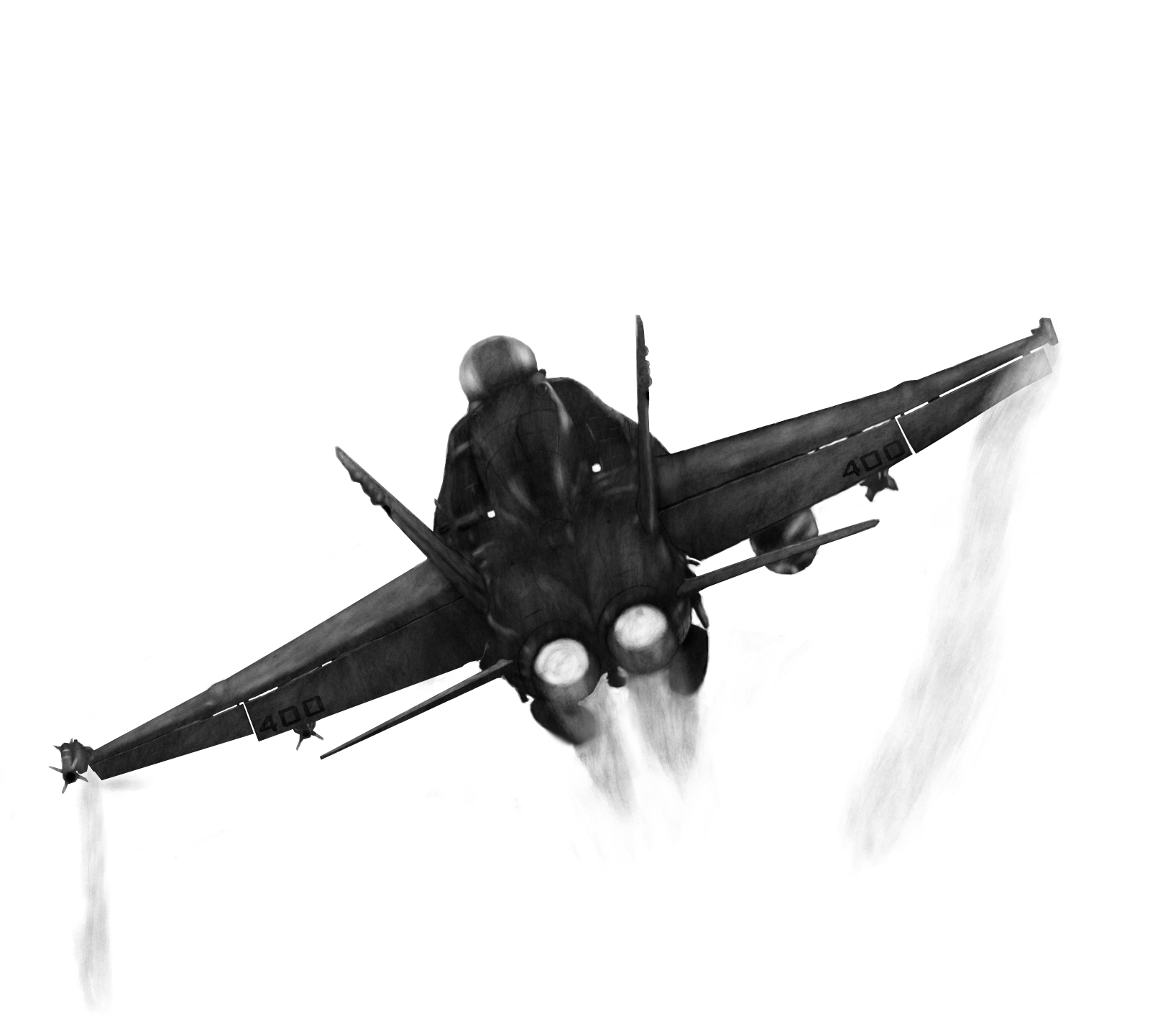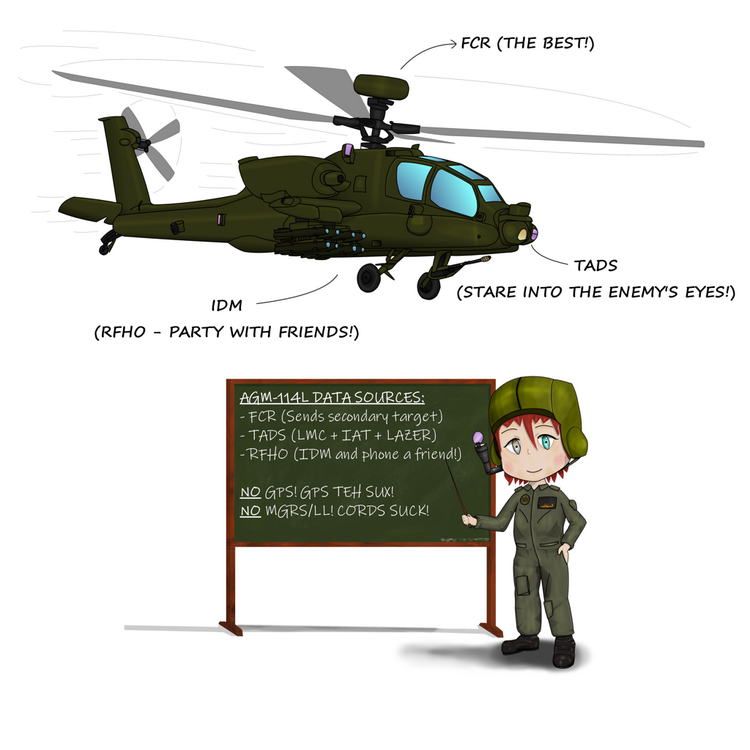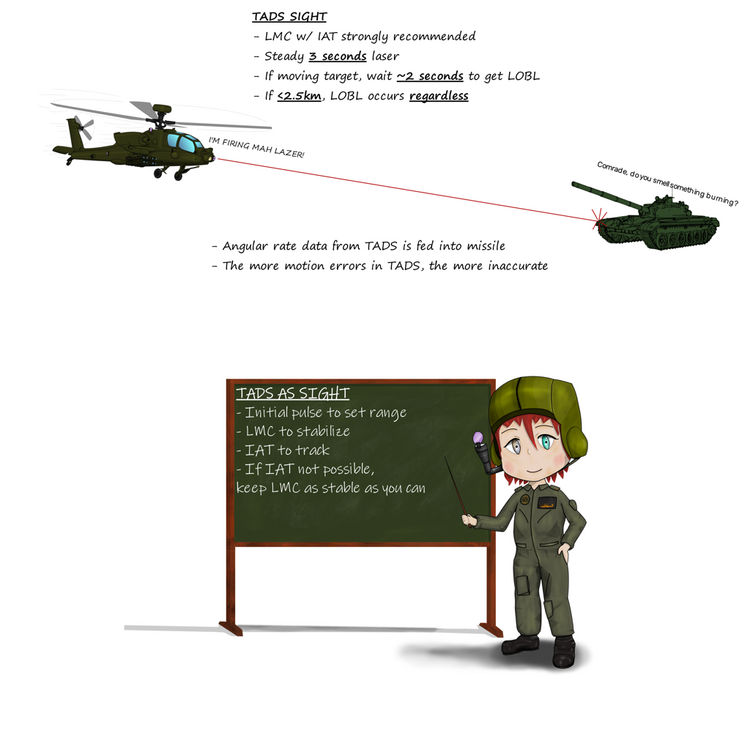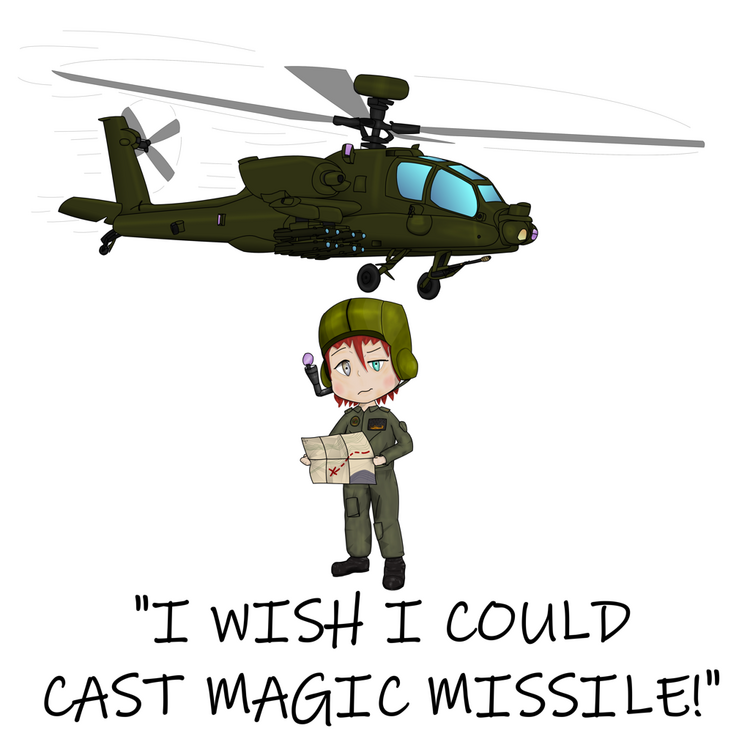-
Posts
703 -
Joined
-
Last visited
Content Type
Profiles
Forums
Events
Everything posted by NeedzWD40
-

How to stabilize TEDAC\TADS image in the moving helicopter?
NeedzWD40 replied to solus's topic in DCS: AH-64D
Are you using a 4/8 way hat or a ministick to control the manual tracker with LMC? I use a ministick and find it extremely precise to utilize LMC, but a hat switch user might want to look at the new sensitivity option in the special settings. The LMC is all the real thing has, plus IAT. You can generate a point and slave to that point if you need the TADS to remain glued to a position. -
Hi Kinkku, can you give a rundown for the changes we can expect in the update? So far I've gathered that the SA342L and Mistral variants will be combined, but it also looks like HOTs will be made available to this variant. Will we see any changes to the radios, ie will the FM radio be fully tunable? Will the ADF tuning knobs be a bit less sensitive?
-

How to stabilize TEDAC\TADS image in the moving helicopter?
NeedzWD40 replied to solus's topic in DCS: AH-64D
What's the problem(s) you're having with it? -
This update is looking very nice! I'm especially happy that the weapons will be rolled into one variant now. Looks like I can stop adding caveats to prospective Gazelle buyers!
-
Are you using the second trigger detent? Performance inhibits (in this case, yaw limit) will prevent firing with the first detent. Make sure you're also not too close as the missile needs more space to maneuver for such a shot. The K won't do this at all, it only looks for laser energy along its flight path.
-

How to stabilize TEDAC\TADS image in the moving helicopter?
NeedzWD40 replied to solus's topic in DCS: AH-64D
Use the LMC to stabilize on the target, then use IAT. Do a quick laser pulse to get a valid range (or manually set range) to adjust the LMC's rate and stability. Also, if you have them visually, use GHS as your acquisition source to rapidly move TADS onto them. -
If at all possible, try to throw in some AI AH-64Ds with Ls. I was testing an enhancement to a scenario that has AI AH-64D and gave them a mixed load of K and L. The mission is quite busy and in singleplayer it can hit frames hard at times, so on a dedicated server I figured that would cause maximum desync. On a whim, I watched as they engaged a column with an SA-8 which also had some armor and trucks in it; the AI would do their usual "defending SAM" while launching a 114L at it, and the missile hit a tank instead! They continued to call out "defending SAM" but each missile hit a different vehicle in the column and only when the SA-8 was the last vehicle was it actually hit. The AI shot entirely L missiles for this engagement. Not conclusive, but now I have a theory. My first go around was against an EWR site protected by an SA-8, AAA, and MANPADS. I locked the SA-8 first and my missile curved right, acquiring a MANPADS standing right and behind the SA-8. The next missile grabbed the big EWR behind the SA-8, then the next a power station by the EWR, followed by a truck behind the SA-8. Only when these were cleared did a missile actually go for the SA-8. There were some AAA pieces remaining after this, each on opposite sides of a hill, but the spread was far enough that the first missile went exactly for the target I wanted. However, the other target was just behind my line of sight, but I wondered what might happen if I lined up as close as possible to the hill and fired a missile to the left. Good lase on the dirt, target to the right for a left missile turn... And the missile picks up the gun pit on the opposite side of the hill. This wasn't repeatable and my next round on a different target, tightly packed SA-8, SHORAD, AAA, etc. and missiles went exactly for SA-8, M48, as desired. I then tried a LOBL launch on a moving column, hit exactly on the lead vehicle. LOBL <2.5km on the now-static M60, right in. Now I'm confused as to what exactly may be going on; hits are hits, just not in the preferred order. I pick a new target and deliberately target short and far, no hits on either. Pick the center vehicle, a Snow Drift and... The missile curves into a AAA truck on the right edge. I found this curious so encouraged a left hand DBS and that missile grabs an SA-11 on the left side! At this time, my theory is that in multiplayer, the missile is going active and grabbing the first target it finds at the edge of the passed position rather than the center of the position. I would say that this would be intended behavior, but as we know, it's not the same in single player, which leads me to believe there is something getting lost in the seeker logic in a network game.
-

AGM-114L and you: Why shouting "I cast magic missile!" doesn't work
NeedzWD40 replied to NeedzWD40's topic in DCS: AH-64D
- 55 replies
-
- 33
-

-

-
Makes it easier to get steady for a good IAT track. If you need to refine your IAT center point it's also easier to move and re-track with LMC.
-
Very, very, very odd question here: What are your results with IAT + LMC? My procedure has always been LMC first, first detent/quick laser pulse for approximate range and stabilize, then IAT. Through this method I've had few failures of my missiles to go for the intended target in multiplayer.
-
IAT tends to break easily in tracks in my experience so I can't trust what I'm seeing on the track. The only time I've had trouble using IAT is if there's a weird obscure condition like a small ridge or object between me and the target. If only part of the vehicle is visible, then IAT usually doesn't work. Never had any problems using it to lock up friendlies, hostiles, or neutrals.
-

Quick way to set acquisition source to PHS as CPG?
NeedzWD40 replied to FalcoGer's topic in DCS: AH-64D
The voice attack example makes me think you could do an external macro with the WPN action button on either MPD, followed by R6 and then R1. -

correct as-is RF 114L curving a lot in flight
NeedzWD40 replied to Ian Boys UK's topic in DCS: AH-64D
Wanted to follow onto this after I tested it in multiplayer, though not one quite as busy (still lots of units) and my experience wasn't quite as peculiar: the first AGM-114L launched would usually not go for the intended target, but every subsequent missile would. I then tried a hot start slot and got the same result, the first missile went for a different (though nearby) target, while every remaining missile would hit exactly what I wanted. Moving convoys, static targets, LOBL inhibited, it didn't matter after that first shot. I deliberately tried to confuse the missile with targets that were tightly packed and static, but this made no difference. -

114L Hellfires consistently miss parked aircraft
NeedzWD40 replied to Floyd1212's topic in Bugs and Problems
I tried a custom mission where the targets are all static, with ground vehicles interspersed with static aircraft and helicopters. The results were interesting: when sighting in a UH-1 and firing missiles only at that UH-1, the surrounding ground vehicles were always acquired first and the UH-1 was only hit when crossing into the threshold of close range LOBL mode. This made me curious if there might be some strange RCS thing at work, so I tested with a static F-117, MiG-25, and two An-26s at different corners of the field. When firing in LOAL mode, the missiles would consistently miss exactly as demonstrated in the original post. However, when closing into LOBL range, the missiles would consistently hit. Adding ground vehicles nearby the static aircraft would generally cause the missiles to acquire these vehicles instead of the aircraft. AGM-114L Static Targets 3.trkAGM-114L Static Targets 2.trk -
This is extremely curious. What would you rate the throw of the NXT vs the CH stick? With my CH stick, I rarely ever use the full range of motion outside of extreme maneuvers. Perhaps the NXT would work better with a more extreme curve and dead zone?
-

114L Hellfires consistently miss parked aircraft
NeedzWD40 replied to Floyd1212's topic in Bugs and Problems
Confirmed, I get the same thing. However, some curious variances: if within LOBL range, the missiles will consistently track the trucks nearby the aircraft, regardless if they're closer or further than the aircraft. Using LOBL INHIBIT results in the above missing behavior. But utilizing this and aiming at just below the static aircraft, like at a wheel or the ground under them, the missile more often hits the aircraft. Using an IAT on the aircraft for precision seems to result in the missile trying to curve for the nose or just in front of it. -
BLUF: The AGM-114L Longbow HELLFIRE is an extremely advanced and capable missile, but is limited by the skill of the crew utilizing it. Preface: The AGM-114L is an active radar guided missile, containing its own radar and inertial system, with the same warhead and motor as an AGM-114K. It is fire and forget, with no input or data links after launch. It can be cued with the TADS, FCR, or RFHO. However, it has a number of limitations that must be understood in order to maximize the weapon's effectiveness. It is not a perfect, flawless, Macross Missile Massacre, kill-all-16-tanks at once, infallible missile. Knowing when and where to use the AGM-114L is an important skill for any aspiring AH-64 crew. The AGM-114L goes into a standby mode at aircraft powerup. This standby mode is largely irrelevant in the context of DCS, but incorporates a number of PBIT features, environmental data, positional data, and other important information. When fully loaded into the standby mode, the missile will be indicated with an S. It remains in this state until the missiles are actioned and given appropriate target data, where they will shift into prelaunch mode. Appropriate target data must be from the correct source, which is limited to the FCR, TADS, or RFHO (Radio Frequency HandOver). Target points, INS coordinates, or other mechanisms are not appropriate sources, as these do not have all the necessary data required for the missile. This data includes a different reference mechanism for the missile (it is not GPS guided nor MGRS/LL referenced), angular target rate, and other important information. Postlaunch occurs after the firing command has been given. This process encompasses all the necessary steps, mostly automatic, that result in the missile launching and heading toward the target. The missile will automatically select LOBL or LOAL modes depending on the nature of the target. Moving targets will almost always attempt LOBL, while stationary targets are generally LOAL. LOBL is the longest range mode due to the nature of moving targets, and will be utilized when targets are moving or attempted when the range is less than 2.5km. Even though LOAL might be indicated <2.5km, the missile will immediately go to terminal acquisition after launch. Beware that when doing so, the missile may not go for the target you specifically want: the missile at this range can grab the first target it finds, which could be closer or further than your intended target. Utilizing the LOBL INHIBIT function can assist with hitting a target closer to a predicted position as opposed to the closest moving target to the position. A DBS trajectory will not occur at ranges less than 2.5km as the distance is too short for effective DBS. Beyond this range, DBS is utilized on stationary targets. DBS may also occur if a moving target stops mid-flight, but only if the range is greater than 2.5km. The trajectory of the missile is based upon the range to the target, where the maximum range will yield a maximum altitude of 3km. DBS trajectories can displace laterally by up to 1km. There are three possible ways to provide targets to the AGM-114L: FCR, TADS, or RFHO. The FCR and TADS are the only self-designation options for the AGM-114L. The FCR is the only one to provide primary and secondary targets to the missile, and at that will only do so if the primary target is stationary. TADS and RFHO are the only ones capable of engaging stationary targets at maximum range. Currently, TADS is the only mechanism available, and thus can only be utilized by the CPG. To use it, the CPG must sight select TADS, at which point the "TYPE" field on the WPN page becomes disbarred, allowing RF to be selected (if SAL missiles are also loaded). Current best practices are to utilize the LMC to align the TADS on target, followed by IAT to track it. A steady lase is required for three seconds to properly pass target data to a missile and failure to do this can result in erratic target data. Hold the laser as long as possible to maximize accuracy. Do not wait long after the target data has been passed to fire, because the greater the time delay, the greater the error in target position. If you're expecting to be able to lase, then hide, do not expect the missile to hit exactly what you're aiming at. Acquire and fire as rapidly as possible. This will be vital when the RFHO arrives, as it too is vulnerable to data errors over time. Plan, assign, and engage rapidly. When launching a missile, keep in mind the relative bearing of the target to the missile's centerline. If the target is to the left of the missile, a DBS profile can cause it to shift right, vice versa if the target is right. The clearer the picture the missile has, the better its overall accuracy. That means you might need to shift the aircraft left or right to present the missile with the best view. Further, if utilizing LOAL and DBS, you can launch missiles that approach from different directions by altering the heading to ensure a left or right trajectory. The closer to the missile's centerline, the more random it may be. Within DCS, after launch the missile immediately gives track warnings, so if the target has a RWR, it is likely to know about your missile. The missile has extremely limited energy potential, so targets with high agility (ie fighter jets) have a much narrower engagement envelope. However, nobody likes the rapid "deedle" of an active-radar homing missile on their RWR, so even a long range shot can alter a potential threat's decision matrix, and the AGM-114L is extremely hard to notch. Helicopters are more vulnerable and they must take significant evasive maneuvers to defeat the missile. Moving targets, while easily tracked with moving target mode, present some additional difficulties. Currently, DCS ground vehicle behavior defaults to dispersion when a unit is hit from the air. In a mobile convoy, this means that after your first missile is shot, if you have any others in flight, they may not track the right target. This is due to a variance in predicted target position at launch versus actual position. The missile is likely to grab the target closest to predicted position, not actual position, so keep this in mind if engaging mobile units. This can also apply to static units that disperse after a hit. If absolute precision is required and a target must be destroyed, then a SAL missile should be the primary tool utilized to destroy it. Remote engagements are far more flexible with SAL missiles, with greater options for masking and targeting. RF missiles are in their element when used against large columns of units where all must be destroyed in a rapid fashion, regardless of order. They should also be the preferred weapon against rotary wing threats and aerial threats, though with the understanding that the more aware the threat is, the less likely the chance of a successful hit.
- 55 replies
-
- 20
-

-

-

correct as-is RF 114L curving a lot in flight
NeedzWD40 replied to Ian Boys UK's topic in DCS: AH-64D
George is having issues with the RF missiles currently, due to how he designates targets. My testing was done from the front seat as I fly and fight from the front seat with no assistance from George. Since George is unable to utilize the LMC and IAT functions currently, this means that the data he passes off to the RF missiles is very spotty. The missile is very persnickety about the target data it receives. -

correct as-is RF 114L curving a lot in flight
NeedzWD40 replied to Ian Boys UK's topic in DCS: AH-64D
Uh, it actually really can't. See the setting on the WPN page when you have RF missiles selected? Says "2ND TARGET INHIBIT"? Basically, the missile can get two targets passed to it during launch. The reason for this is if it can't find the primary, it will fall back to the secondary. If it can't find either, it goes to the INS coordinates it has. It's up to the crew to ensure the best possible PK (in this context, "Probability of Kill"), which includes understanding the missile's envelope. Firing the missile on a maneuvering target at 8km has a very low PK. I rigorously tested the AGM-114L yesterday and the only thing I had trouble killing were Mi-24s maneuvering at max range and fast movers. Crossing to about 6km made for a much greater hit rate on the Mi-24, and 4km were almost always hits. Tail on against a Su-25, I was able to make a shot at 3km and score a hit. Ground vehicles didn't matter, they couldn't maneuver fast enough to save their lives, plus moving vehicles were perfect for LOBL shots. You should always be trying to get a LOBL box on moving targets, it just takes a hair longer to make an acquisition. -
I use a full CH setup, Fighterstick, throttle, and pedals. A slight curve on pitch, bank, and yaw axises, with Y saturation at 90 and a deadzone of 10 on each axis.
-
What's your trim setting in special options? Is there an FMC disconnect caution message on the EUFD?
-

how to select a specific hellfire in a mixed loadout
NeedzWD40 replied to skypickle's topic in DCS: AH-64D
If as the pilot: it won't be possible to action the RF missiles until the FCR or datalink are in place. You will have to rely on George/CPG to shoot the RF missiles. If as the CPG: Sight select TADS, then action missiles, then on the WPN page, select where it says "TYPE" to toggle between RF and SAL missiles. -
I tested the FM and SAS changes today in a variety of trials and here are my current observations: FMC off is markedly improved, with far more stability in hover, flight, and aerobatics. Pretty much translates 1:1 with the FTR depressed. It feels possible to get into a hover without lots of oscillations now. Aerobatics are markedly improved, with a lot of the troublesome characteristics (excessive roll tendency, yaw oscillations) gone now. Rolls and loops can be executed well and with precision. Hovering feels more like it does with other helicopters, with only minor cyclic changes to keep it steady. I was able to take my hands off the collective and pedals, using only the cyclic to maintain position. If a heading change was required, it wasn't nearly the same fight as it was in the past, with either FTR or pedal. SAS behavior with roll and yaw is markedly improved, with the tendency to slip into snap rolls significantly reduced. I tried to induce the previous snap roll behavior and was unable to get an unwanted roll to occur, but someone with more issues with it will need to test as I was careful to not get into it (pressing FTR for evasive usually kept me safe). Taxi behavior with tailwheel unlocked is still something of a challenge, with oscillations still occurring on the pedals. It's not impossible to dial in, but I suspect that most will still have major problems with taxiing and rolling takeoffs. Takeoff and landing is no longer a "jump" up or down to stay safe and my general feeling is that I can get light on the wheels without risking a rollover. There's still a tendency for the aircraft to want to tip, but it's not nearly as pronounced as it used to be. Overall, I find it an incremental improvement, but if you were struggling in the past I don't think the recent patch will change perceptions. It hasn't gone to "easy," but it has tamed some of the more annoying quirks.
-

fixed George CPG cannot control LST switch
NeedzWD40 replied to Varry007's topic in Bugs and Problems
Have you checked to see if he's leaving the LST switch in auto? -
So, something else this brings to mind: when using the FCR as a sensor, 114L is range limited to ~6km when engaging static targets. The FCR can't detect static targets beyond this range, though it can see moving ones. This means that using the datalink will be extremely useful because one aircraft can fly closer with an FCR, bob up and run a sweep, then send the targets back to other aircraft with a RFHO. The firing aircraft can remain masked and from maximum range, thus enabling an alternative mechanism in this scenario's case. Overall, it once again proves that both seekers have their place and carrying a mix is ideal. For the record, the 114L flies to a certain altitude based on range to the target, so at maximum range it will climb to ~3km above the launch point. It can also potentially shift left or right by up to a kilometer. This can be handy if you're dealing with certain threats like SA-15, where you might put him on the left for the first shot, then on the right for the second, allowing two missiles to approach from opposite directions.







